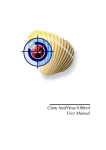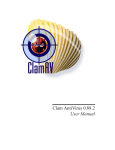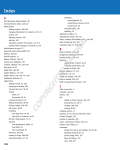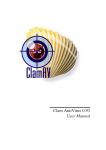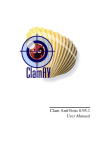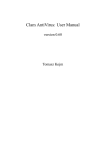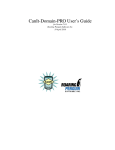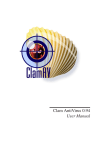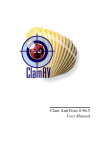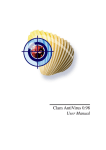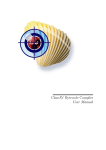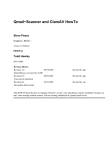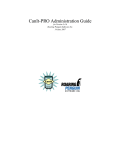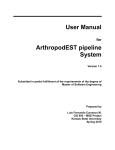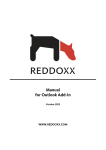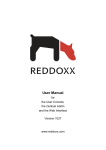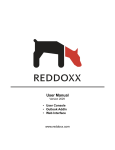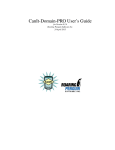Download Clam AntiVirus 0.80 User Manual
Transcript
Clam AntiVirus 0.80
User Manual
1
Contents
Contents
1
Introduction
1.1 Features . . . . . . . . . . . . . . . . . . . . . . . . . . . . . . . . . .
1.2 Mailing lists . . . . . . . . . . . . . . . . . . . . . . . . . . . . . . . .
1.3 Virus submitting . . . . . . . . . . . . . . . . . . . . . . . . . . . . . .
5
5
6
6
2
Base package
2.1 Supported platforms . . . . . . . . . . . . . . . . . . . . . . . . . . . .
2.2 Binary packages . . . . . . . . . . . . . . . . . . . . . . . . . . . . . .
2.3 Daily built snapshots . . . . . . . . . . . . . . . . . . . . . . . . . . .
6
6
7
9
3
Installation
3.1 Requirements . . . . . . . . . . . . . .
3.2 Installing on a shell account . . . . . .
3.3 Adding new system user and group . . .
3.4 Compilation of base package . . . . . .
3.5 Compilation with clamav-milter enabled
4
5
6
Configuration
4.1 clamd . . . . . . . . . . .
4.1.1 On-access scanning
4.2 clamav-milter . . . . . . .
4.3 Testing . . . . . . . . . . .
4.4 Setting up auto-updating .
4.5 Closest mirrors . . . . . .
Usage
5.1 Clam daemon . .
5.2 Clamdscan . . .
5.3 Clamuko . . . . .
5.4 Output format . .
5.4.1 clamscan
5.4.2 clamd . .
.
.
.
.
.
.
.
.
.
.
.
.
.
.
.
.
.
.
.
.
.
.
.
.
.
.
.
.
.
.
.
.
.
.
.
.
.
.
.
.
.
.
.
.
.
.
.
.
.
.
.
.
.
.
.
.
.
.
.
.
.
.
.
.
.
.
.
.
.
.
.
.
.
.
.
.
.
.
.
.
.
.
.
.
.
.
.
.
.
.
.
.
.
.
.
.
.
.
.
.
.
.
.
.
.
.
.
.
.
.
.
.
.
.
.
.
.
.
.
.
.
.
.
.
.
.
.
.
.
.
.
.
.
.
.
.
.
.
.
.
.
.
.
.
.
.
.
.
.
.
.
.
.
.
.
.
.
.
.
.
.
.
.
.
.
.
.
.
.
.
.
.
.
.
.
.
.
.
.
.
.
.
.
.
.
.
.
.
.
.
.
.
.
.
.
.
.
.
.
.
.
.
.
.
.
.
.
.
.
.
.
.
.
.
.
.
.
.
.
.
.
.
.
9
9
10
10
11
11
.
.
.
.
.
.
12
12
12
13
13
14
15
.
.
.
.
.
.
.
.
.
.
.
.
.
.
.
.
.
.
.
.
.
.
.
.
.
.
.
.
.
.
.
.
.
.
.
.
.
.
.
.
.
.
.
.
.
.
.
.
.
.
.
.
.
.
.
.
.
.
.
.
.
.
.
.
.
.
.
.
.
.
.
.
.
.
.
.
.
.
.
.
.
.
.
.
.
.
.
.
.
.
.
.
.
.
.
.
.
.
.
.
.
.
.
.
.
.
.
.
.
.
.
.
.
.
15
15
16
16
17
17
18
LibClamAV
6.1 Licence . . . . . . . . . . . . . . . .
6.2 Features . . . . . . . . . . . . . . . .
6.2.1 Archives and compressed files
6.2.2 Mail files . . . . . . . . . . .
.
.
.
.
.
.
.
.
.
.
.
.
.
.
.
.
.
.
.
.
.
.
.
.
.
.
.
.
.
.
.
.
.
.
.
.
.
.
.
.
.
.
.
.
.
.
.
.
.
.
.
.
.
.
.
.
.
.
.
.
.
.
.
.
.
.
.
.
.
.
.
.
19
19
19
19
20
.
.
.
.
.
.
.
.
.
.
.
.
.
.
.
.
.
.
.
.
.
.
.
.
.
.
.
.
.
.
.
.
.
.
.
.
.
.
.
.
.
.
.
.
.
.
.
.
.
.
.
.
.
.
.
.
.
.
.
.
2
Contents
6.3
6.4
6.5
API . . . . . . . . . . . .
6.3.1 Header file . . . .
6.3.2 Database loading .
6.3.3 Error handling . .
6.3.4 Database structure
Database reloading . . . .
6.4.1 Data scan functions
6.4.2 Memory . . . . . .
6.4.3 clamav-config . . .
6.4.4 Example . . . . .
CVD format . . . . . . . .
.
.
.
.
.
.
.
.
.
.
.
.
.
.
.
.
.
.
.
.
.
.
.
.
.
.
.
.
.
.
.
.
.
7
Frequently Asked Questions
8
Third party software
8.1 IVS Milter . . . . . . . . . . . .
8.2 smtp-vilter . . . . . . . . . . . .
8.3 mod clamav . . . . . . . . . . .
8.4 AMaViS - ”Next Generation” . .
8.5 amavisd-new . . . . . . . . . .
8.6 Qmail-Scanner . . . . . . . . .
8.7 Sagator . . . . . . . . . . . . .
8.8 ClamdMail . . . . . . . . . . .
8.9 MailScanner . . . . . . . . . . .
8.10 MIMEDefang . . . . . . . . . .
8.11 exiscan . . . . . . . . . . . . .
8.12 Mail::ClamAV . . . . . . . . . .
8.13 File::Scan::ClamAV . . . . . . .
8.14 OpenAntiVirus samba-vscan . .
8.15 Sylpheed Claws . . . . . . . . .
8.16 nclamd . . . . . . . . . . . . . .
8.17 cgpav . . . . . . . . . . . . . .
8.18 j-chkmail . . . . . . . . . . . .
8.19 qscanq . . . . . . . . . . . . . .
8.20 clamavr . . . . . . . . . . . . .
8.21 pyclamav . . . . . . . . . . . .
8.22 DansGuardian Anti-Virus Plugin
8.23 Viralator . . . . . . . . . . . . .
8.24 ClamAssassin . . . . . . . . . .
8.25 clamscan-procfilter . . . . . . .
8.26 MyClamMailFilter . . . . . . .
.
.
.
.
.
.
.
.
.
.
.
.
.
.
.
.
.
.
.
.
.
.
.
.
.
.
.
.
.
.
.
.
.
.
.
.
.
.
.
.
.
.
.
.
.
.
.
.
.
.
.
.
.
.
.
.
.
.
.
.
.
.
.
.
.
.
.
.
.
.
.
.
.
.
.
.
.
.
.
.
.
.
.
.
.
.
.
.
.
.
.
.
.
.
.
.
.
.
.
.
.
.
.
.
.
.
.
.
.
.
.
.
.
.
.
.
.
.
.
.
.
.
.
.
.
.
.
.
.
.
.
.
.
.
.
.
.
.
.
.
.
.
.
.
.
.
.
.
.
.
.
.
.
.
.
.
.
.
.
.
.
.
.
.
.
.
.
.
.
.
.
.
.
.
.
.
.
.
.
.
.
.
.
.
.
.
.
.
.
.
.
.
.
.
.
.
.
.
.
.
.
.
.
.
.
.
.
.
.
.
.
.
.
.
.
.
.
.
.
.
.
.
.
.
.
.
.
.
.
.
.
20
20
20
21
21
22
22
25
25
25
25
26
.
.
.
.
.
.
.
.
.
.
.
.
.
.
.
.
.
.
.
.
.
.
.
.
.
.
.
.
.
.
.
.
.
.
.
.
.
.
.
.
.
.
.
.
.
.
.
.
.
.
.
.
.
.
.
.
.
.
.
.
.
.
.
.
.
.
.
.
.
.
.
.
.
.
.
.
.
.
.
.
.
.
.
.
.
.
.
.
.
.
.
.
.
.
.
.
.
.
.
.
.
.
.
.
.
.
.
.
.
.
.
.
.
.
.
.
.
.
.
.
.
.
.
.
.
.
.
.
.
.
.
.
.
.
.
.
.
.
.
.
.
.
.
.
.
.
.
.
.
.
.
.
.
.
.
.
.
.
.
.
.
.
.
.
.
.
.
.
.
.
.
.
.
.
.
.
.
.
.
.
.
.
.
.
.
.
.
.
.
.
.
.
.
.
.
.
.
.
.
.
.
.
.
.
.
.
.
.
.
.
.
.
.
.
.
.
.
.
.
.
.
.
.
.
.
.
.
.
.
.
.
.
.
.
.
.
.
.
.
.
.
.
.
.
.
.
.
.
.
.
.
.
.
.
.
.
.
.
.
.
.
.
.
.
.
.
.
.
.
.
.
.
.
.
.
.
.
.
.
.
.
.
.
.
.
.
.
.
.
.
.
.
.
.
.
.
.
.
.
.
.
.
.
.
.
.
.
.
.
.
.
.
.
.
.
.
.
.
.
.
.
.
.
.
.
.
.
.
.
.
.
.
.
.
.
.
.
.
.
.
.
.
.
.
.
.
.
.
.
.
.
.
.
.
.
.
.
.
.
.
.
.
.
.
.
.
.
.
.
.
.
.
.
.
.
.
.
.
.
.
.
.
.
.
.
.
.
.
.
.
.
.
.
.
.
.
.
.
.
.
.
.
.
.
.
.
.
.
.
.
.
.
.
.
.
.
.
.
.
.
.
.
.
.
.
.
.
.
.
.
.
.
.
.
.
.
.
.
.
.
.
.
.
.
.
.
.
.
.
.
.
.
.
.
.
.
.
.
.
.
.
.
.
.
.
.
.
.
.
.
.
.
.
.
.
.
.
.
.
.
.
.
.
.
.
.
.
.
.
.
.
.
.
.
.
.
.
.
.
.
.
.
.
.
.
.
.
.
.
.
.
.
.
.
.
.
.
.
.
.
.
.
.
.
.
.
.
.
.
.
.
.
.
.
.
.
.
.
.
.
.
.
.
.
.
.
30
30
30
30
31
31
31
31
32
32
32
32
32
33
33
33
33
33
33
34
34
34
34
34
35
35
35
3
Contents
8.27
8.28
8.29
8.30
8.31
8.32
8.33
8.34
8.35
8.36
8.37
8.38
8.39
8.40
8.41
8.42
8.43
8.44
8.45
8.46
8.47
8.48
8.49
8.50
8.51
8.52
8.53
8.54
8.55
8.56
9
Gadoyanvirus . . . . . . . . . . . . . .
OpenProtect . . . . . . . . . . . . . . .
RevolSys SMTP kit for Postfix . . . . .
POP3 Virus Scanner Daemon . . . . . .
mailman-clamav . . . . . . . . . . . .
wbmclamav . . . . . . . . . . . . . . .
Scan Log Analyzer . . . . . . . . . . .
mailgraph . . . . . . . . . . . . . . . .
INSERT . . . . . . . . . . . . . . . . .
Local Area Security . . . . . . . . . . .
redWall Firewall . . . . . . . . . . . . .
ClamWin . . . . . . . . . . . . . . . .
KlamAV . . . . . . . . . . . . . . . . .
Clamaktion . . . . . . . . . . . . . . .
QMVC - Qmail Mail and Virus Control
FETCAV . . . . . . . . . . . . . . . .
Famuko . . . . . . . . . . . . . . . . .
SoftlabsAV . . . . . . . . . . . . . . .
OdeiaVir . . . . . . . . . . . . . . . . .
ClamSMTP . . . . . . . . . . . . . . .
Protea AntiVirus Tools . . . . . . . . .
PTSMail Utilities . . . . . . . . . . . .
mxGuard for IMail . . . . . . . . . . .
BeClam . . . . . . . . . . . . . . . . .
clamXav . . . . . . . . . . . . . . . . .
Secure Mail Intelligence! . . . . . . . .
OpenWebMail modules . . . . . . . . .
simscan . . . . . . . . . . . . . . . . .
Zabit . . . . . . . . . . . . . . . . . . .
qSheff . . . . . . . . . . . . . . . . . .
Credits
9.1 Database mirrors
9.2 Contributors . . .
9.3 Donors . . . . . .
9.4 Graphics . . . . .
9.5 OpenAntiVirus .
.
.
.
.
.
.
.
.
.
.
.
.
.
.
.
.
.
.
.
.
.
.
.
.
.
.
.
.
.
.
.
.
.
.
.
.
.
.
.
.
.
.
.
.
.
.
.
.
.
.
.
.
.
.
.
.
.
.
.
.
.
.
.
.
.
.
.
.
.
.
.
.
.
.
.
.
.
.
.
.
.
.
.
.
.
.
.
.
.
.
.
.
.
.
.
.
.
.
.
.
.
.
.
.
.
.
.
.
.
.
.
.
.
.
.
.
.
.
.
.
.
.
.
.
.
.
.
.
.
.
.
.
.
.
.
.
.
.
.
.
.
.
.
.
.
.
.
.
.
.
.
.
.
.
.
.
.
.
.
.
.
.
.
.
.
.
.
.
.
.
.
.
.
.
.
.
.
.
.
.
.
.
.
.
.
.
.
.
.
.
.
.
.
.
.
.
.
.
.
.
.
.
.
.
.
.
.
.
.
.
.
.
.
.
.
.
.
.
.
.
.
.
.
.
.
.
.
.
.
.
.
.
.
.
.
.
.
.
.
.
.
.
.
.
.
.
.
.
.
.
.
.
.
.
.
.
.
.
.
.
.
.
.
.
.
.
.
.
.
.
.
.
.
.
.
.
.
.
.
.
.
.
.
.
.
.
.
.
.
.
.
.
.
.
.
.
.
.
.
.
.
.
.
.
.
.
.
.
.
.
.
.
.
.
.
.
.
.
.
.
.
.
.
.
.
.
.
.
.
.
.
.
.
.
.
.
.
.
.
.
.
.
.
.
.
.
.
.
.
.
.
.
.
.
.
.
.
.
.
.
.
.
.
.
.
.
.
.
.
.
.
.
.
.
.
.
.
.
.
.
.
.
.
.
.
.
.
.
.
.
.
.
.
.
.
.
.
.
.
.
.
.
.
.
.
.
.
.
.
.
.
.
.
.
.
.
.
.
.
.
.
.
.
.
.
.
.
.
.
.
.
.
.
.
.
.
.
.
.
.
.
.
.
.
.
.
.
.
.
.
.
.
.
.
.
.
.
.
.
.
.
.
.
.
.
.
.
.
.
.
.
.
.
.
.
.
.
.
.
.
.
.
.
.
.
.
.
.
.
.
.
.
.
.
.
.
.
.
.
.
.
.
.
.
.
.
.
.
.
.
.
.
.
.
.
.
.
.
.
.
.
.
.
.
.
.
.
.
.
.
.
.
.
.
.
.
.
.
.
.
.
.
.
.
.
.
.
.
.
.
.
.
.
.
.
.
.
.
.
.
.
.
.
.
.
.
.
.
.
.
35
35
36
36
36
36
37
37
37
37
37
38
38
38
38
38
39
39
39
39
39
39
40
40
40
40
41
41
41
41
.
.
.
.
.
.
.
.
.
.
.
.
.
.
.
.
.
.
.
.
.
.
.
.
.
.
.
.
.
.
.
.
.
.
.
.
.
.
.
.
.
.
.
.
.
.
.
.
.
.
.
.
.
.
.
.
.
.
.
.
.
.
.
.
.
.
.
.
.
.
.
.
.
.
.
.
.
.
.
.
.
.
.
.
.
41
41
45
53
56
56
Contents
10 Authors
4
56
ClamAV User Manual, c 2002 - 2004 Tomasz Kojm
This document is distributed under the terms of the GNU General Public License v2.
Clam AntiVirus is free software; you can redistribute it and/or modify it under the
terms of the GNU General Public License as published by the Free Software Foundation; either version 2 of the License, or (at your option) any later version.
This program is distributed in the hope that it will be useful, but WITHOUT ANY
WARRANTY; without even the implied warranty of MERCHANTABILITY or FITNESS FOR A PARTICULAR PURPOSE. See the GNU General Public License for
more details.
You should have received a copy of the GNU General Public License along with this
program; if not, write to the Free Software Foundation, Inc., 675 Mass Ave, Cambridge, MA 02139, USA.
1 Introduction
5
1 Introduction
Clam AntiVirus is an anti-virus toolkit for UNIX, designed for e-mail scanning on mail
gateways. It provides a flexible and scalable multi-threaded daemon, a command line
scanner, and an advanced tool for automatic database updating via Internet. The package
also includes a virus scanner shared library.
1.1 Features
Licensed under the GNU General Public License, Version 2
POSIX compliant, portable
Fast scanning
Supports on-access scanning (Linux and FreeBSD only)
Detects over 20000 viruses, worms, and trojans, including Microsoft Office and
MacOffice macro viruses
Scans within archives and compressed files (also protects against archive bombs),
built-in support includes:
–
–
–
–
–
–
–
–
–
Zip
RAR (2.0)
Tar
Gzip
Bzip2
MS OLE2
MS Cabinet Files
MS CHM (Compiled HTML)
MS SZDD compression format
Supports Portable Executable files compressed with:
– UPX
– FSG
– Petite
Powerful mail scanner
Advanced database updater with support for digital signatures and DNS based
database version queries
6
2 Base package
1.2 Mailing lists
If you have a trouble installing or using ClamAV try to ask on our mailing lists. There
are four lists available:
clamav-announce*lists.clamav.net - info about new versions, moderated 1 .
clamav-users*lists.clamav.net - user questions
clamav-devel*lists.clamav.net - technical discussions
clamav-virusdb*lists.clamav.net - database update announcements, moderated
You can subscribe and search the mailing list archives at: http://www.clamav.net/
ml.html
1.3 Virus submitting
If you have got a virus which is not detected by your ClamAV with the latest databases,
please check it with the ClamAV Online Specimen Scanner:
http://test-clamav.power-netz.de/
and then submit it on our website:
http://www.clamav.net/sendvirus.html
2 Base package
2.1 Supported platforms
All popular operating systems are supported. Clam AntiVirus was tested on:
GNU/Linux
Solaris
FreeBSD
OpenBSD 2
AIX 4.1/4.2/4.3/5.1
1 Subscribers
2 Installation
are not allowed to post to the mailing list
from a port is recommended.
2 Base package
7
HPUX 11.0
SCO UNIX
IRIX 6.5.20f
Mac OS X
BeOS
Cobalt MIPS boxes
Cygwin
Windows Services for Unix 3.5 (Interix)
Some features may not be available on your operating system. If you are successfully
running Clam AntiVirus on a system not listed above please let us know.
2.2 Binary packages
Debian
The package is maintained by Stephen Gran and Thomas Lamy. ClamAV has
been officially included in the Debian distribution starting from the Sarge release. Run apt-cache search clamav to find the names of the packages available for installation. Unofficial packages for Woody and Sarge are available and
they are usually more recent than official ones. Add the following lines to your
/etc/apt/sources.list:
for stable/woody (i386):
deb http://people.debian.org/˜sgran/debian woody main
deb-src http://people.debian.org/˜sgran/debian woody main
for testing/sarge (i386):
deb http://people.debian.org/˜sgran/debian sarge main
deb-src http://people.debian.org/˜sgran/debian sarge main
Feel free to search for clamav on http://www.apt-get.org/ too.
RedHat - Fedora
The packages are maintained by Petr Kristof.
Fedora1: http://crash.fce.vutbr.cz/crash-hat/1/clamav/
Fedora2: http://crash.fce.vutbr.cz/crash-hat/2/clamav/
Devel snapshots: http://crash.fce.vutbr.cz/crash-hat/testing/2/
Please follow the instructions at http://crash.fce.vutbr.cz/yum-repository.
html and then run:
2 Base package
8
yum update clamav
or
up2date -u clamav
Another very good repository is maintained by Dag Wieers: http://dag.wieers.
com/packages/clamav/
PLD Linux Distribution
The RPM packages for the Polish(ed) Linux Distribution are maintained by Arkadiusz Miskiewicz (visit http://www.pld-linux.org/).
Mandrake
A RPM package for Mandrake is available on Mandrake’s mirrors and is maintained by Oden Eriksson. Another set of RPM packages (maintained by Bill Randle) is available at ftp://ftp.neocat.org/pub/.
Slackware
Slackware packages without milter support are maintained by Jay Scott Raymond.
You can find them at http://webpages.charter.net/jay_scott_raymond/
linux/slackages/ If you need milter enabled ClamAV, try Peter Kaagman’s
packages available at http://bilbos-stekkie.com/clamav/
Both of them are also available at http://www.linuxpackages.net/
SuSE SuSE 8.2 and 9.1 RPMs are maintained by Joe Benden. You can download them at http://www.ispservices.com/clamav.html. Official ClamAV
packages for SuSE are maintained by Reinhard Max.
FreeBSD
The official FreeBSD port is maintained by Masahiro Teramoto. There are two
version available: clamav and clamav-devel. You can find both of them under
/usr/ports/security/
OpenBSD
The unofficial port for OpenBSD is available at: http://www.fatbsd.com/
openbsd/clamav/
NetBSD
The official port is available.
AIX
The binary packages for AIX are available in AIX PDSLIB, UCLA
http://aixpdslib.seas.ucla.edu/packages/clamav.html
9
3 Installation
Mac OS X
There’s a binary package available at http://clamav.darwinports.com/
clamXav (see 8.51), a GUI for ClamAV running on MacOS X, is available at
http://www.markallan.co.uk/clamXav
BeOS
BeClam is a port of ClamAV for the BeOS operating system. It includes a very
simple GUI. Get it at http://www.bebits.com/app/3930/
MS Windows - Cygwin
All major features of ClamAV are implemented under Win32 using the Cygwin
compatibility layer. You can download a self-installing package at
http://www.sosdg.org/clamav-win32/index.php
MS Windows - Interix
A binary package of ClamAV for Interix is maintained at
http://www.interopsystems.com/tools/warehouse.htm
MS Windows - graphical version
A standalone GUI version is also available. See ClamWin in the Third Party
Software section (8.38).
2.3 Daily built snapshots
Thanks to Fajar A. Nugraha you can download daily builds (from daily snapshots) for
the following operating systems:
SPARC Solaris 8/9
DEC OSF (built on Tru64 UNIX V5.0A)
AIX (built on AIX Version 5.1)
Linux i386 with glibc 2.3 (compiled on Fedora Core 1, works on RH
Win32/Cygwin (compiled on XP)
They’re available at http://clamav.or.id/
3 Installation
3.1 Requirements
The following elements are required to compile ClamAV:
8)
3 Installation
10
zlib and zlib-devel packages
gcc compiler suite (both 2.9x and 3.x are supported)
The following packages are optional but highly recommended:
bzip2 and bzip2-devel library
GNU MP 3
It’s very important to install the GMP package because it allows freshclam to
verify the digital signatures of the virus databases. If freshclam was compiled
without GMP support it will display ”SECURITY WARNING: NO SUPPORT
FOR DIGITAL SIGNATURES” on every update. You can download GNU MP at
http://www.swox.com/gmp/
A note for Solaris/SPARC users: you must set the ABI system variable to 32 (e.g.
setenv ABI 32) before running the configuration script of GMP.
3.2 Installing on a shell account
To install ClamAV on a shell account (e.g. on some shared host) you need not create any
additional users or groups. Assuming your home directory is /home/gary you should
build it as follows:
$ ./configure --prefix=/home/gary/clamav --disable-clamav
$ make; make install
To test your installation execute:
$ ˜/clamav/bin/freshclam
$ ˜/clamav/bin/clamscan ˜
The --disable-clamav switch disables testing for the existence of the clamav user and
group but clamscan would still require an unprivileged account to work in a superuser
mode.
3.3 Adding new system user and group
If you are installing ClamAV for the first time, you have to add a new user and group to
your system: 3
3 Cygwin
note: If you have not /etc/passwd you can skip this procedure
3 Installation
11
# groupadd clamav
# useradd -g clamav -s /bin/false -c "Clam AntiVirus" clamav
Consult a system manual if your OS has not groupadd and useradd utilities. The account
should be locked in /etc/passwd or /etc/shadow.
3.4 Compilation of base package
Once you have created the clamav user and group, please extract the archive:
$ zcat clamav-x.yz.tar.gz | tar xvf $ cd clamav-x.yz
Assuming you want to install the configuration files in /etc, configure the package as
follows:
$ ./configure --sysconfdir=/etc
Currently gcc is required to compile ClamAV.
$ make
$ su -c "make install"
In the last step the software is installed in the /usr/local directory and the config file
goes to /etc. WARNING: Never enable the SUID or SGID bits in Clam AntiVirus
binaries.
3.5 Compilation with clamav-milter enabled
libmilter and its development files are required. To enable clamav-milter, configure
ClamAV with
$ ./configure --enable-milter
4 Configuration
12
4 Configuration
4.1 clamd
If you are going to use the daemon, you have to edit the configuration file (in other case
clamd won’t run):
$ clamd
ERROR: Please edit the example config file /etc/clamd.conf.
This shows the location of the default configuration file. The format and options of this
file are fully described in the clamd.conf(5) manual. The config file is well commented
and configuration should be straightforward.
4.1.1 On-access scanning
An interesting feature of clamd is on-access scanning based on the Dazuko module,
available from http://dazuko.org/. It is not required to run clamd - furthermore,
you shouldn’t run Dazuko on production systems. The special thread in clamd responsible for the communication with Dazuko is called ”Clamuko” (due to the funny
name of Dazuko) and it’s only supported on Linux and FreeBSD. To compile dazuko
execute:
$ tar zxpvf dazuko-a.b.c.tar.gz
$ cd dazuko-a.b.c
$ make dazuko
or
$ make dazuko-smp (for smp kernels)
$ su
# insmod dazuko.o
# cp dazuko.o /lib/modules/‘uname -r‘/misc
# depmod -a
Depending on your Linux distribution you have to add a ”dazuko” entry to /etc/modules
or run the module during system’s startup by adding
modprobe dazuko
to some startup file. You must also create a new device:
4 Configuration
13
$ cat /proc/devices | grep dazuko
254 dazuko
$ su -c "mknod -m 600 /dev/dazuko c 254 0"
Now configure Clamuko in clamd.conf and read the 5.3 section.
4.2 clamav-milter
Nigel Horne’s clamav-milter is a very fast email scanner designed for Sendmail. It’s
written entirely in C and only depends on clamd. You can find detailed installation
instructions in the INSTALL file that comes with the clamav-milter sources. Basically,
to connect it with Sendmail add the following lines to /etc/mail/sendmail.mc:
INPUT_MAIL_FILTER(‘clmilter’,‘S=local:/var/run/clmilter.sock,
F=, T=S:4m;R:4m’)dnl
define(‘confINPUT_MAIL_FILTERS’, ‘clmilter’)
Check entry in clamd.conf of the form:
LocalSocket /var/run/clamd.sock
Start clamav-milter
/usr/local/sbin/clamav-milter -lo /var/run/clmilter.sock
and restart sendmail.
4.3 Testing
Try to scan recursively the source directory:
$ clamscan -r -l scan.txt clamav-x.yz
It should find some test files in the clamav-x.yz/test directory. The scan result will be
saved in the scan.txt log file 4 . To test clamd, start it and use clamdscan (or connect
directly to its socket and run the SCAN command instead):
$ clamdscan -l scan.txt clamav-x.yz
Please note that the scanned files must be accessible by the user running clamd or you
get an error.
4 To
get more info on clamscan options execute ’man clamscan’
4 Configuration
14
4.4 Setting up auto-updating
freshclam is the default database updater for Clam AntiVirus. It can work in two
modes:
interactive - from command line, verbosely
daemon - alone, silently
When started by a superuser it drops privileges and switches to the clamav user. freshclam
uses the database.clamav.net round-robin DNS which automatically selects a database
mirror9.1. freshclam is an advanced tool: it supports database version verification
through DNS, proxy servers (with authentication), digital signatures and various error
scenarios. Quick test: run freshclam (as superuser) with no parameters and check
the output. If everything is OK you may create the log file in /var/log (owned by clamav
or another user freshclam will be running as (--user):
# touch /var/log/clam-update.log
# chmod 600 /var/log/clam-update.log
# chown clamav /var/log/clam-update.log
Now you should edit the configuration file (freshclam.conf or clamd.conf if they’re
merged) and configure the UpdateLogFile directive to point to the created log file. Finally, to run freshclam in the daemon mode, execute:
# freshclam -d
The other method is to use the cron daemon. You have to add the following line to the
crontab of the root or clamav users:
N * * * * /usr/local/bin/freshclam --quiet
to check for a new database every hour. N should be a number between 3 and 57
of your choice. Please don’t choose any multiple of 10, because there are already
too many clients using those time slots. Proxy settings are only configurable via the
configuration file and freshclam will require strict permissions on the config file when
HTTPProxyPassword is enabled.
HTTPProxyServer myproxyserver.com
HTTPProxyPort 1234
HTTPProxyUsername myusername
HTTPProxyPassword mypass
5 Usage
15
4.5 Closest mirrors
The DatabaseMirror directive in the config file specifies the database server freshclam
will attempt (up to MaxAttempts times) to download the database from. The default
database mirror is database.clamav.net but multiple directives are allowed. In order
to download the database from the closest mirror you should configure freshclam to
use db.xx.clamav.net where xx represents your country code. For example, if your
server is in ”Ascension Island” you should add the following lines to freshclam.conf:
DNSDatabaseInfo current.cvd.clamav.net
DatabaseMirror db.ac.clamav.net
DatabaseMirror database.clamav.net
The second entry acts as a fallback in case a connection to the first mirror fails for some
reason. The full list of two-letters country codes is available at http://www.iana.
org/cctld/cctld-whois.htm
5 Usage
5.1 Clam daemon
clamd is a multi-threaded daemon that uses libclamav to scan files against viruses. It
may work in one of the two network modes, listening on a:
Unix (local) socket
TCP socket
The daemon is fully configurable via the clamd.conf file 5 . clamd recognizes the
following commands:
PING
Check daemon state (should reply with ”PONG”).
VERSION
Print program and database versions.
RELOAD
Reload databases.
SHUTDOWN
Perform a clean exit.
5 man
5 clamd.conf
5 Usage
16
SCAN file/directory Scan file or directory (recursively) with archive support enabled (a full path is required).
RAWSCAN file/directory Scan file or directory (recursively) with archive support disabled (a full path is required).
CONTSCAN file/directory Scan file or directory (recursively) with archive support enabled and do not stop scanning if virus is found.
STREAM Scan stream: clamd will return a new port number you should connect
to and send data to scan.
SESSION, END Start/end a clamd session - you can do multiple commands per
TCP session (WARNING: due to the clamd implementation the RELOAD command will break the session).
and reacts to the special signals:
SIGTERM - perform a clean exit
SIGHUP - reopen a log file
SIGUSR2 - reload the database
5.2 Clamdscan
clamdscan is a simple clamd client. In many cases you can use it as a clamscan
replacement but you must remember that:
it only depends on clamd
although it accepts the same command line options as clamscan most of them are
ignored because they must be enabled directly in clamd, i.e. clamd.conf
scanned files must be accessible for clamd
it can’t use external unpackers
5.3 Clamuko
Clamuko is a special thread in clamd that performs on-access scanning under Linux and
FreeBSD and shares internal virus database with the daemon. You must follow some
important rules when using it:
5 Usage
17
Always stop the daemon cleanly - using the SHUTDOWN command or the
SIGTERM signal. In other case you can lose an access to protected files until the
system is restarted.
Never protect a directory your mail-scanner software uses for attachment unpacking. Access to all infected files will be automatically blocked and the scanner
(even clamd) won’t be able to detect any virus. In the result all infected mails
will be delivered.
For example, to protect a whole system add the following lines to clamd.conf:
ClamukoScanOnAccess
ClamukoIncludePath /
ClamukoExcludePath /proc
ClamukoExcludePath /temporary/dir/of/your/mail/scanning/software
You can also use clamuko to protect files on Samba/Netatalk but far more better and
safe idea is to use the samba-vscan module (see 8.14). NFS is not supported because
Dazuko doesn’t intercept NFS access calls.
5.4 Output format
5.4.1 clamscan
clamscan by default writes all messages to stderr. Run it with --stdout enabled to
redirect them to the standard output. An example of the clamscan output is:
/tmp/test/removal-tool.exe: Worm.Sober FOUND
/tmp/test/md5.o: OK
/tmp/test/blob.c: OK
/tmp/test/message.c: OK
/tmp/test/error.hta: VBS.Inor.D FOUND
When a virus is found its name is printed between the filename: and FOUND strings. In
case of archives the scanner depends on libclamav and only prints the first virus found
within an archive:
zolw@localhost:/tmp$ clamscan malware.zip
malware.zip: Worm.Mydoom.U FOUND
5 Usage
18
TIP: You can force clamscan to list all infected files in an archive using –no-archive
(that disables transparent decompressors built into libclamav) and external decompressors: –unzip –unrar....
zolw@localhost:/tmp$ clamscan --no-archive --unzip malware.zip
Archive: /tmp/malware.zip
inflating: test1.exe
inflating: test2.exe
inflating: test3.exe
/tmp/clamav-77e7bfdbb2d3872b/test1.exe: Worm.Mydoom.U FOUND
/tmp/clamav-77e7bfdbb2d3872b/test2.exe: Trojan.Taskkill.A FOUND
/tmp/clamav-77e7bfdbb2d3872b/test3.exe: Worm.Nyxem.D FOUND
/tmp/malware.zip: Infected Archive FOUND
5.4.2 clamd
clamd uses a clamscan compatible output format:
zolw@localhost:˜$ telnet localhost 3310
Trying 127.0.0.1...
Connected to localhost.
Escape character is ’ˆ]’.
SCAN /home/zolw/test
/home/zolw/test/clam.exe: ClamAV-Test-File FOUND
Connection closed by foreign host.
In the SCAN mode it closes the connection when the first virus is found.
SCAN /home/zolw/test/clam.zip
/home/zolw/test/clam.zip: ClamAV-Test-File FOUND
CONTSCAN continues scanning even if virus was already found.
Error messages are printed in the following format:
SCAN /no/such/file
/no/such/file: Can’t stat() the file. ERROR
6 LibClamAV
19
6 LibClamAV
libclamav is a simple and easy way to add a virus protection to your software. The
library is thread-safe and transparently recognizes and scans within archives, mail files,
MS Office document files, executables and other file formats.
6.1 Licence
libclamav is licensed under the GNU GPL licence. That means you are not allowed
to link commercial, close-source applications against it6 . All software using libclamav
must be GPL compliant.
6.2 Features
6.2.1 Archives and compressed files
The library has a built-in support for the following formats:
Zip
RAR (2.0)
Tar
Gzip
Bzip2
MS OLE2
MS Cabinet Files
MS CHM (Compiled HTML)
MS SZDD compression format
UPX (all versions)
FSG (1.3, 1.31, 1.33)
Petite (2.x)
6 You
can still use clamd or clamscan instead
20
6 LibClamAV
Due to license issues, support for RAR 3.0 archives is currently not available in libclamav (they will cause RAR module failure. error message). You can scan them with
help of external unpackers in clamscan, though.
$ clamscan --unrar clam-error.rar
/home/zolw/test/clam-error.rar: RAR module failure.
UNRAR 3.00 freeware
Copyright (c) 1993-2002 Eugene Roshal
Extracting from /home/zolw/test/clam-error.rar
Extracting clam.exe
All OK
/tmp/44694f5b2665d2f4/clam.exe: ClamAV-Test-File FOUND
/home/zolw/test/clam-error.rar: Infected Archive FOUND
OK
6.2.2 Mail files
Advanced mail scanner built into libclamav transparently scans e-mails for infected
attachments. All popular UNIX mail formats are supported.
6.3 API
6.3.1 Header file
Every program using libclamav must include the clamav.h header file:
#include <clamav.h>
6.3.2 Database loading
The following set of functions provides an interface to database initialisation mechanisms:
int cl_loaddb(const char *filename, struct cl_node **root,
unsigned int *signo);
int cl_loaddbdir(const char *dirname, struct cl_node **root,
unsigned int *signo);
6 LibClamAV
21
const char *cl_retdbdir(void);
cl_loaddb loads selected database while cl_loaddbdir loads all databases from a
dirname directory. cl_retdbdir returns a default (hardcoded) database directory path.
After an initialisation an internal database representation will be saved under root
(which must initially point to NULL) and a number of loaded signatures will be added
7 to virnum. You can eventually pass NULL if you don’t care about a signature counter.
Both cl_loaddb and cl_loaddbdir functions return 0 on success and a non-negative
value on failure.
...
struct cl_node *root = NULL;
int ret, signo = 0;
ret = cl_loaddbdir(cl_retdbdir(), &root, &signo);
6.3.3 Error handling
Use cl_strerror to convert error codes into human readable messages. The function
returns a statically allocated string:
if(ret) {
printf("cl_loaddbdir() error: %s\n", cl_strerror(ret));
exit(1);
}
6.3.4 Database structure
Now initialise internal transitions with cl_build.
int cl_build(struct cl_node *root);
In our example:
if((ret = cl_build(root)))
printf("cl_build() error: %s\n", cl_strerror(ret));
7 Remember
to initialize the virus counter variable with 0.
6 LibClamAV
22
6.4 Database reloading
The most important thing is to keep the internal instance of the database up to date. You
can watch database changes with the cl_stat functions family.
int cl_statinidir(const char *dirname, struct cl_stat *dbstat);
int cl_statchkdir(const struct cl_stat *dbstat);
int cl_statfree(struct cl_stat *dbstat);
Initialization:
...
struct cl_stat dbstat;
memset(&dbstat, 0, sizeof(struct cl_stat));
cl_statinidir(dbdir, &dbstat);
To check for a change you only need to call cl_statchkdir:
if(cl_statchkdir(&dbstat) == 1) {
reload_database...;
cl_statfree(&dbstat);
cl_statinidir(cl_retdbdir(), &dbstat);
}
Remember to reinitialize the structure after reload.
6.4.1 Data scan functions
It’s possible to scan a buffer, a descriptor, or a file with:
int cl_scanbuff(const char *buffer, unsigned int length,
const char **virname, const struct cl_node *root);
int cl_scandesc(int desc, const char **virname, unsigned
long int *scanned, const struct cl_node *root, const
struct cl_limits *limits, unsigned int options);
int cl_scanfile(const char *filename, const char **virname,
unsigned long int *scanned, const struct cl_node *root,
const struct cl_limits *limits, unsigned int options);
6 LibClamAV
23
All the functions save a virus name under virname pointer. It points to a field in the
internal database structure and must not be released directly. If the scanned pointer
is not NULL the functions will increase a value represented by this pointer by a size
of scanned data in CL_COUNT_PRECISION units. The last two functions also support
archive limits required to protect against Denial of Service attacks.
struct cl_limits {
int maxreclevel; /* maximal recursion level */
int maxfiles; /* maximal number of files to be
* scanned within archive
*/
int maxratio; /* maximal compression ratio */
short archivememlim; /* limit memory usage for bzip2 (0/1) */
long int maxfilesize; /* archived files larger than this
* value will not be scanned
*/
};
The options argument configures the scan engine and supports the following flags (that
can be combined using bit operators):
CL SCAN STDOPT
This is an alias for a recommended set of scan options. You should use it to make
your software ready for new features in future versions of libclamav.
CL SCAN RAW
It does nothing. Please use it (alone) if you don’t want to scan any special files.
CL SCAN ARCHIVE
This flag enables transparent scanning of various archive formats.
CL SCAN BLOCKENCRYPTED
With this flag the library marks encrypted archives as viruses (Encrypted.Zip,
Encrypted.RAR).
CL SCAN BLOCKMAX
Mark archives as viruses if maxfiles, maxfilesize, or maxreclevel limit is
reached.
CL SCAN MAIL
It enables support for mail files.
6 LibClamAV
24
CL SCAN MAILURL
The mail scanner will download and scan URLs listed in a mail body. This flag
should not be used on loaded servers. Due to potential problems please do not
enable it by default but make it optional.
CL SCAN OLE2
Enables support for Microsoft Office document files.
CL SCAN PE
This flag enables scanning withing Portable Executable files and allows libclamav
to unpack UPX, Petite, and FSG compressed executables.
CL SCAN BLOCKBROKEN
libclamav will try to detect broken executables and mark them as Broken.Executable.
CL SCAN HTML
This flag enables HTML normalisation (including JScript decryption).
All functions return 0 (CL_CLEAN) if the file is clean, CL_VIRUS when virus is detected
and an another value on failure.
...
struct cl_limits limits;
const char *virname;
memset(&limits, 0, sizeof(struct cl_limits));
/* maximal number of files in archive */;
limits.maxfiles = 1000
/* maximal archived file size */
limits.maxfilesize = 10 * 1048576; /* 10 MB */
/* maximal recursion level */
limits.maxreclevel = 5;
/* maximal compression ratio */
limits.maxratio = 200;
/* disable memory limit for bzip2 scanner */
limits.archivememlim = 0;
if((ret = cl_scanfile("/home/zolw/test", &virname, NULL, root,
&limits, CL_STDOPT)) == CL_VIRUS) {
printf("Detected %s virus.\n", virname);
} else {
printf("No virus detected.\n");
if(ret != CL_CLEAN)
6 LibClamAV
25
printf("Error: %s\n", cl_strerror(ret));
}
6.4.2 Memory
Because the internal database uses a few megabytes of memory, you should release it if
you no longer need to scan files.
void cl_free(struct cl_node *root);
6.4.3 clamav-config
Use clamav-config to check libclamav compilation information.
zolw@localhost:˜$ clamav-config --libs
-L/usr/local/lib -lz -lbz2 -lgmp -lpthread
zolw@localhost:˜$ clamav-config --cflags
-I/usr/local/include -g -O2
6.4.4 Example
You will find an example scanner application in the clamav sources (/example). Remember that all programs based on libclamav must be linked against it:
gcc -Wall ex1.c -o ex1 -lclamav
6.5 CVD format
CVD (ClamAV Virus Database) is a digitally signed tarball file that contains one or
more databases. The header is a 512 bytes long string with colon separated fields:
ClamAV-VDB:build time:version:number of signatures:functionality
level required:MD5 checksum:digital signature:builder name:build time (sec)
sigtool --info displays detailed information on CVD files:
7 Frequently Asked Questions
26
zolw@localhost:/usr/local/share/clamav$ sigtool -i daily.cvd
Build time: 11 Sep 2004 21-07 +0200
Version: 487
# of signatures: 1189
Functionality level: 2
Builder: ccordes
MD5: a3f4f98694229e461f17d2aa254e9a43
Digital signature: uwJS6d+y/9g5SXGE0Hh1rXyjZW/PGK/zqVtWWVL3/tfHEn
A17z6VB2IBR2I/OitKRYzmVo3ibU7bPCJNgi6fPcW1PQwvCunwAswvR0ehrvY/4ks
UjUOXo1VwQlW7l86HZmiMUSyAjnF/gciOSsOQa9Hli8D5uET1RDzVpoWu/id
Verification OK.
7 Frequently Asked Questions
The FAQ section is maintained by Luca Gibelli.
What does WARNING: Current functionality level = 1, required = 2 mean?
The functionality level of the database determines which scanner engine version
is required to use all of its signatures. If you don’t upgrade immediately you will
be in big trouble.
What does SECURITY WARNING: NO SUPPORT FOR DIGITAL SIGNATURES mean?
The ClamAV package requires the GMP library to verify the digital signature of
the virus database. When building ClamAV you need the GMP library and its
headers: if you are using Debian just run apt-get install libgmp3-dev, if
you are using an RPM based distribution install the gmp-devel package.
How often is the virus database updated?
The virus database is usually updated many times per week. Check out http:
//news.gmane.org/gmane.comp.security.virus.clamav.virusdb/ to see
our response times to new threats. The virusdb team tries to keep up with the
latest worm in the wild. When a new worm spreads out, often it is less than one
hour before we release a database update. You can contribute to make the virusdb
updating process more efficient by submitting samples of viruses via our web
interface.
I tried to submit a sample through the web interface, but it said the sample
is already recognized by ClamAV. My clamscan tells me it’s not. I already
updated my database, what’s wrong with my setup?
7 Frequently Asked Questions
27
Please run clamscan with the –mbox option. Also check that freshclam and clamscan are using the same path for storing/reading the database.
ClamAV crashes/hangs/doesn’t compile/doesn’t start. Did I find a bug?
Before reporting a bug, please download the latest CVS code and try to reproduce
the bug with it. Chances are the bug you encountered has already been fixed. If
you really feel like you found a bug, please send a message bugs*clamav.net.
How do I automatically restart clamd when it dies?
Set up a cronjob which checks that clamd is up and running, every XX minutes.
You can find an example script in the contrib/clamdwatch/ directory. You
can also read how to run clamd supervised in the docs/clamd_supervised/
directory.
How do I keep my virus database up to date?
ClamAV comes with freshclam, a tool which periodically checks for new database
releases and keeps your database up to date.
I’m running ClamAV on a lot of clients on my local network. Can I mirror
the database locally so that each client doesn’t have to download it from your
servers?
Sure, install a proxy server and then configure your freshclam clients to use it
(watch for the HTTPProxyServer parameter in man freshclam.conf). Alternatively, you can configure a local webserver on one of your machines (say machine1.mylan) and let freshclam download the *.cvd files from http://database.
clamav.net/ to the webserver’s DocumentRoot. Finally, change freshclam.conf
on your clients so that it reads: DatabaseMirror machine1.mylan First the
database will be downloaded to the local webserver and then the other clients on
the network will update their copy of the database from it.
How can I list the virus signature names contained in the database?
If you are using a recent version of ClamAV just run: $sigtool --list-sigs
I found an infected file in my HD/floppy/mailbox, but ClamAV doesn’t recognize it yet. Can you help me?
Our virus database is kept up to date with the help of the community. Whenever
you find a new virus which is not detected by ClamAV you should submit it on
our website (go to www.clamav.net and click on submit sample). The virusdb
team will review your submission and update the database if necessary. Before
submitting a new sample:
– check that the value of DatabaseDirectory, in both clamd.conf and
freshclam.conf, is the same
7 Frequently Asked Questions
28
– update your database by running freshclam
Why is ClamAV calling the XXX virus with another name?
This usually happens when we add a signature before other AV vendors. No wellknown name is available at that moment so we have to invent one. Renaming
the virus after a few days would just confuse people more, so we usually keep
on using our name for that virus. The only exception is when a new name is
established soon after the signature addition. You can find more info about this in
the virus naming page at http://www.clamav.net/cvdinfo.html
How do I know when database updates are released?
Subscribe to the clamav-virusdb mailing-list.
How can I scan a file on my hard disk for viruses without installing ClamAV?
Use the online scanning tool available at http://test-clamav.power-netz.
de/
I found a false positive in ClamAV virus database. What shall I do?
Fill the form at http://www.clamav.net/sendvirus.html Be sure to select
The file attached is... a false positive
How do I verify the integrity of ClamAV sources?
Using GnuPG (http://www.gnupg.org/) you can easily verify the authenticity
of your stable release downloads by using the following method:
– Download Tomasz Kojm’s key from the clamav.net site:
$ wget http://www.clamav.net/gpg/tkojm.gpg
– Import the key into your local public keyring:
\$ gpg --import tkojm.gpg
– Download the stable release AND the corresponding .sig file to the same
directory.
$ wget http://prdownloads.sourceforge.net/clamav/clamav-X.XX.tar.gz
$ wget http://prdownloads.sourceforge.net/clamav/clamav-X.XX.tar.gz.sig
– Verify that the stable release download is signed with the proper key:
$ gpg --verify clamav-X.XX.tar.gz.sig
– Make sure the resulting output contain the following information:
Good signature from Tomasz Kojm (tk*lodz.tpnet.pl)
Can ClamAV disinfect files?
No, it can’t. We will add support for disinfecting OLE2 files in one of the next
7 Frequently Asked Questions
29
stable releases. There are no plans for disinfecting other types of files. There are
many reasons for it: cleaning viruses from files is virtually pointless these days.
It is very seldom that there is anything useful left after cleaning, and even if there
is, would you trust it?
When using clamscan, is there a way to know which message within an mbox
is infected?
No, clamscan stops at the first infected message. You can convert the mbox to
Maildir format, run clamscan on it and then convert it back to mbox format. There
are many tools available which can convert to and from Maildir format, e.g: formail, mbox2maildir, and maildir2mbox.
I’m running qmail+Qmail-Scanner+ClamAV and get the following error in
my mail logs: clamdscan: corrupt or unknown clamd scanner error or memory/resource/perms problem. What’s wrong with it?
Most likely clamd is not running at all, or you are running Qmail-Scanner and
clamd under a different uid. If you are running Qmail-Scanner as qscand (default setting) you could put User qscand inside your clamd.conf file and restart
clamd. Remember to check that qscand can create clamd.ctl (usually located at
/var/run/clamav/clamd.ctl). The same applies to the log file.
How do I use ClamAV with p3scan?
Add the following lines to your pop3vscan configuration file:
virusregexp = .*: (.*) FOUND
scanner = /usr/bin/clamdscan --no-summary -i
scannertype = basic
Where can I ask questions about using ClamAV?
Subscribe to our clamav-users mailing-list at http://www.clamav.net/ml.html
Where can I get the latest CVS snapshot of ClamAV?
Basically, there are two ways:
– Run
cvs -d:pserver:anonymous @ cvs.sourceforge.net:/cvsroot/clamav co clamav-de
– Visit http://www.clamav.net/snapshot/
I’m a MS Windows user. Can I take advantage of ClamAV virus protection?
Yes, you can use ClamWin, a port of ClamAV for win32 systems with a very nice
graphic interface. Download it at http://www.clamwin.net
8 Third party software
30
Where can I find more information about ClamAV?
Please read this documentation. You can also try searching the mailing list archives.
If you can’t find the answer, you can ask for support on the clamav-users mailinglist, but please before doing it, search the archives! Also, make sure that you
don’t send HTML-ized email messages and that you don’t top-post (these violate
the netiquette and lessen your chances of being answered).
How can I contribute to the ClamAV project?
There are many ways to contribute to the ClamAV project. See the donations page
(http://www.clamav.net/donate.html for more info.
8 Third party software
There are many projects with support for our scanner. Here is the list of software that
was tested and is known to work well.
8.1 IVS Milter
Homepage: http://ivs-milter.lbsd.net/
Supports: clamd
IVS Milter is a virus and spam scanning milter. The name stands for Industrial Virus +
Spam milter. It’s designed to be used by anything from home users to large ISPs.
8.2 smtp-vilter
Homepage: http://www.etc.msys.ch/software/smtp-vilter/
Supports: clamd
smtp-vilter is a high performance content filter for sendmail using the milter API. The
software scans e-mail messages for viruses and drops or marks infected messages. ClamAV is the default scanner backend.
8.3 mod clamav
Homepage: http://software.othello.ch/mod_clamav/
Supports: libclamav, clamd
mod clamav is an Apache virus scanning filter. It was written and is currently maintained by Andreas Muller. The project is very well documented and the installation is
quite easy.
8 Third party software
31
8.4 AMaViS - ”Next Generation”
Homepage: http://sourceforge.net/projects/amavis/
Supports: clamscan
AMaViS-ng is a rewritten, more modular version of amavis-perl/amavisd, developed by
Hilko Bengen. Installation:
Please download the newest version (at least 0.1.4). After installation (which is quite
easy), please uncomment the following line in amavis.conf:
virus-scanner = CLAM
and if it’s needed change the path to clamscan in the [CLAM] section:
[CLAM]
clamscan = /usr/local/bin/clamscan
8.5 amavisd-new
Homepage: http://www.ijs.si/software/amavisd/
Supports: clamd, clamscan
amavisd-new is a rewritten version of amavis maintained by Mark Martinec.
Installation:
clamscan is enabled automatically if clamscan binary is found at amavisd-new startup
time. clamd is activated by uncommenting its entry in the @av scanners list, file
/etc/amavisd.conf.
8.6 Qmail-Scanner
Homepage: http://qmail-scanner.sf.net/
Supports: clamscan
Please increase the softlimit value if you are going to use it with clamscan.
8.7 Sagator
Homepage: http://www.salstar.sk/sagator/
Supports: clamscan, clamd, libclamav
This program is an email antivirus/antispam gateway. It is an interface to the postfix
8 Third party software
32
(or any other smtpd), which runs antivirus and/or spamchecker. Its modular architecture
can use any combination of antivirus/spamchecker according to configuration.
8.8 ClamdMail
Homepage: http://clamdmail.sf.net/
Supports: clamd
A mail processing client for ClamAV. Small, fast and easy to install.
8.9 MailScanner
Homepage: http://www.mailscanner.info/
Supports: clamscan
MailScanner scans all e-mail for viruses, spam and attacks against security vulnerabilities. It is not tied to any particular virus scanner, but can be used with any combination
of 14 different virus scanners, allowing sites to choose the ”best of breed” virus scanner.
8.10 MIMEDefang
Homepage: http://www.roaringpenguin.com/mimedefang
Supports: clamscan, clamd
This is an efficient mail scanner for Sendmail/milter.
8.11 exiscan
Homepage: http://duncanthrax.net/exiscan-acl/
Supports: clamscan, clamd
exiscan is a patch against exim version 4, providing support for content scanning in
email messages received by exim. Four different scanning facilities are supported: antivirus, antispam, regular expressions, and file extensions.
8.12 Mail::ClamAV
Homepage: http://cpan.gossamer-threads.com/modules/by-authors/id/S/SA/
SABECK/
Supports: libclamav
Perl binding for ClamAV.
8 Third party software
33
8.13 File::Scan::ClamAV
Homepage: http://search.cpan.org/˜cfaber/File-Scan-ClamAV-1.06/lib/File/
Scan/ClamAV.pm
Supports: clamd
Scan files and control clamd directly from Perl.
8.14 OpenAntiVirus samba-vscan
Homepage: http://www.openantivirus.org/projects.php#samba-vscan
Supports: clamd
samba-vscan provides on-access scanning of Samba shares. It supports Samba 2.2.x/3.0
with working virtual file system (VFS) support.
8.15 Sylpheed Claws
Homepage: http://claws.sylpheed.org/
Supports: libclamav
Sylpheed Claws is a bleeding edge branch of Sylpheed, a light weight mail user agent
for UNIX. It can scan attachments in mail received from POP, IMAP or a local account
and optionally delete the mail or save it to a designated folder.
8.16 nclamd
Homepage: http://www.kyzo.com/nclamd/
Supports: libclamav
nclamd, nclamav-milter and nclamdscan are rewritten versions of the original tools and
use processes instead of threads and ripMIME instead of the clamav built-in MIME
decoder.
8.17 cgpav
Homepage: http://program.farit.ru/
Supports: clamd
This is a fast (written in C) CommuniGate Pro anti-virus plugin with support for clamd.
8.18 j-chkmail
Homepage: http://j-chkmail.ensmp.fr/
Supports: libclamav, clamd
8 Third party software
34
j-chkmail is a fast (written in C) filter for sendmail. It does spam and dangerous content
(virus) filtering with help of ClamAV. The program supports many modes of monitoring
and run time controlling and was designed to work on highly loaded servers. It’s an
open source software available for free to registered users (for non-commercial usage).
8.19 qscanq
Homepage: http://budney.homeunix.net:8080/users/budney/software/qscanq/
index.html
Supports: clamscan
qscanq replaces qmail-queue. It initiates a scan (using clamscan or clamdscan) on an
incoming email, and returns the exit status of the scanner or of qmail-queue to the caller.
8.20 clamavr
Homepage: http://raa.ruby-lang.org/list.rhtml?name=clamavr
Supports: libclamav
Ruby binding for ClamAV.
8.21 pyclamav
Homepage: http://xael.org/norman/python/pyclamav/index.html
Supports: libclamav
Python binding for ClamAV.
8.22 DansGuardian Anti-Virus Plugin
Homepage: http://www.pcxperience.org/dgvirus/
Supports: clamscan
DG AVP is a GPL add-on that takes the Virus Scanning capabilities of MailScanner and
integrates them into the content filtering web proxy DansGuardian.
8.23 Viralator
Homepage: http://viralator.sourceforge.net/
Supports: clamscan
Viralator is a perl script that virus scans http downloads on a linux server after passing
through the squid proxy server.
8 Third party software
35
8.24 ClamAssassin
Homepage: http://drivel.com/clamassassin/
Supports: clamscan
clamassassin is a simple script for virus scanning with clamscan which works similarily
to spamassassin. It’s designed for integration with procmail.
8.25 clamscan-procfilter
Homepage: http://www.virtualblueness.net/˜blueness/clamscan-procfilter/
Supports: clamscan
A procmail filter for clamscan to work in conjunction with procmail. A new email field,
X-CLAMAV, with all the viruses found, is generated in the email header.
8.26 MyClamMailFilter
Homepage: http://muncul0.w.interia.pl/projects.html#myclammailfilter
Supports: clamscan
MyClamMailFilter is an e-mail filter for procmail or maildrop. When a virus is found,
it renames attachments and modifies the subject. It can also rename potentially dangerous attachments looking at their extensions. The software is simple, fast and easy to
customize.
8.27 Gadoyanvirus
Homepage: http://oss.mdamt.net/gadoyanvirus/
Supports: libclamav
gadoyanvirus is a (yet another) virus stopper for qmail. It replaces the original qmailqueue program. It scans incoming messages using the ClamAV anti-virus library. Suspected message will be quarantined and (optionally) a notification message will be sent
to the recipients. By default, gadoyanvirus needs QMAILQUEUE patched qmail installation.
8.28 OpenProtect
Homepage: http://opencompt.com/
Supports: ClamAV via MailScanner
OpenProtect is a server side e-mail protection solution consisting of MailScanner, Spamassassin, ClamAV with support for Sendmail, Postfix, Exim and qmail. It also consists
8 Third party software
36
of a fully automatic installer and uninstaller, which configures everything automatically
including setting up perl modules and virus scanner settings.
8.29 RevolSys SMTP kit for Postfix
Homepage: http://smtp.revolsys.org/
Supports: ClamAV via amavisd-new
The RevolSyS SMTP kit for Postfix provides an antispam and antivirus tools installation. It uses amavisd-new, Spamassassin, ClamAV, and Razor. It aims to enhance an
already-installed mail server running Postfix.
8.30 POP3 Virus Scanner Daemon
Homepage: http://p3scan.sourceforge.net/
Supports: clamscan
This is a full-transparent proxy-server for POP3-clients. It runs on a Linux box with
iptables (for port re-direction). It can be used to provide POP3 email scanning from the
Internet, to any internal network and is ideal for helping to protect your Other OS LAN
from harm, especially when used in conjunction with a firewall and other Internet Proxy
servers.
8.31 mailman-clamav
Homepage: http://www.tummy.com/Software/mailman-clamav/
Supports: clamd
This module includes a Mailman handler for scanning incoming messages through ClamAV. The handler allows Mailman to be configured to hold or discard messages which
contain viruses. Particularly useful is the discard option, which prevents list administrators from having to manually deal with viruses.
8.32 wbmclamav
Homepage: http://wbmclamav.labs.libre-entreprise.org/
Supports: ClamAV
wbmclamav is a webmin module to manage Clam AntiVirus, written by Emmanuel
Saracco.
8 Third party software
37
8.33 Scan Log Analyzer
Homepage: http://pandaemail.sourceforge.net/av-tools/
Supports: ClamAV
Scan analyzer allows you to plot and view graphical representation of log data from
virus logs of RAV, ClamAV and Vexira.
8.34 mailgraph
Homepage: http://people.ee.ethz.ch/˜dws/software/mailgraph/
Supports: clamd
mailgraph is a very simple mail statistics RRDtool frontend for Postfix that produces
daily, weekly, monthly and yearly graphs of received/sent and bounced/rejected mail
(SMTP traffic).
8.35 INSERT
Homepage: http://www.inside-security.de/INSERT_en.html
Supports: ClamAV
INSERT (the Inside Security Rescue Toolkit) aims to be a multi-functional, multipurpose disaster recovery and network analysis system. It boots from a credit cardsized CD-ROM and is basically a stripped-down version of Knoppix. It features good
hardware detection, fluxbox, emelfm, links-hacked, ssh, tcpdump, nmap, chntpwd, and
much more. It provides full read-write support for NTFS partitions (using captive), and
the ClamAV virus scanner (including the signature database).
8.36 Local Area Security
Homepage: http://www.localareasecurity.com/
Supports: ClamAV
Local Area Security Linux is a Live CD distribution with a strong emphasis on security
tools and small footprint. It can be used to run ClamAV from a CDROM.
8.37 redWall Firewall
Homepage: http://redwall.sourceforge.net/
Supports: ClamAV
redWall is a bootable CD-ROM firewall which focuses on web-based reporting of the
firewall’s status. It supports virus filtering with amavisd-new and ClamAV.
8 Third party software
38
8.38 ClamWin
Homepage: http://clamwin.sourceforge.net/
Supports: clamscan, freshclam
ClamWin provides Graphical User Interface to Clam AntiVirus scanning engine. It
allows to select and scan a folder or file, configure settings and update virus databases.
It also includes a Windows Taskbar tray icon. ClamWin also features a context menu
handler for Windows Explorer which installs Scan into the right-click explorer menu
for files and folders. The package comes with an installer built with InnoSetup. Cygwin
dlls are included.
8.39 KlamAV
Homepage: http://sourceforge.net/projects/klamav/
Supports: ClamAV
ClamAV Anti-Virus protection for the KDE desktop. The features include: ’on access’
scanning, manual scanning, quarantine management, downloading updates, mail scanning (KMail/Evolution), automated installation (ClamAV and Dazuko pre-packaged).
8.40 Clamaktion
Homepage: http://web.tiscali.it/rospolosco/clamaktion/
Supports: clamscan
clamaktion is a little utility which allows KDE 3 users to scan files and directories with
clamscan from the right-click Konqueror menu.
8.41 QMVC - Qmail Mail and Virus Control
Homepage: http://www.fehcom.de/qmail/qmvc.html
Supports: clamdscan, clamscan
QMVC is an unidirectional mail filter for qmail. It works in conjunction with the ”dotqmail” mechanism for qmail-local and is entirely designed for qmail (no additional
patches required).
8.42 FETCAV
Homepage: http://www.thymox.uklinux.net/
Supports: clamscan
FETCAV stands for Front End To Clam AntiVirus. It’s a GUI interface to ClamAV and
requires Xdialog.
8 Third party software
39
8.43 Famuko
Homepage: http://www.campana.vi.it/ottavio/Progetti/Famuko/
Supports: libclamav
Famuko is an on-access scanner based on libfam and working in a userspace.
8.44 SoftlabsAV
Homepage: http://antivirus.softlabs.info/
Supports: clamscan
Softlabs AntiVirus is a generic anti-virus filter for incoming mail servers on Unix, running as plugin for procmail. In addition, it plugs to the Clam AntiVirus scanner (clamscan) if available.
8.45 OdeiaVir
Homepage: http://odeiavir.sourceforge.net/
Supports: clamdscan
OdeiaVir is an e-mail filter for qmail or Exim.
8.46 ClamSMTP
Homepage: http://memberwebs.com/nielsen/software/clamsmtp/
Supports: clamd
ClamSMTP is an SMTP filter for Postfix and other mail servers that checks for viruses
using the ClamAV anti-virus software. It aims to be lightweight, reliable, and simple
rather than have a myriad of options. Written in C without major dependencies.
8.47 Protea AntiVirus Tools
Homepage: http://www.proteatools.com/
Supports: clamd
Protea AntiVirus Tools for Lotus Domino scans and cleans automatically attached files
and other objects in Domino mail. Clam AntiVirus scanner is used for virus detection.
Fully configurable scheduled database scanning offers an additional layer of protection.
8.48 PTSMail Utilities
Homepage: http://www.scanmail-software.com/
Supports: clamscan
8 Third party software
40
PTSMail uses clamscan as part of the ptsfilter (a sendmail milter).
8.49 mxGuard for IMail
Homepage: http://www.mxguard.com/postmaster/
Supports: clamscan
mxGuard is a spam filter for Ipswitch IMail mail server running on Windows platforms.
It also includes free hooks to major anti-virus engines including ClamAV.
8.50 BeClam
Homepage: http://www.bebits.com/app/3930/
Supports: ClamAV
ClamAV for BeOS 0.74
8.51 clamXav
Homepage: http://www.markallan.co.uk/clamXav
Supports: ClamAV
clamXav is a virus scanner with GUI for Mac OS X.
8.52 Secure Mail Intelligence!
Homepage: http://www.m2smi.com/
Supports: libclamav
SMI! is a server side e-mail protection solution that combines firewall elements, intrusion detection system, anti-virus and anti-spam modules. SMI! can use up to 7 anti-virus
scanners (including ClamAV) at the same time and 3 different spam filtering engines. A
built-in SMTP engine allows SMI! to directly send mail alerts. Other features include:
Routing & Queuing Module, Disclaimer & Messages Module, Updater Module, Policy CheckModule, Mail Storage Module, Image Analysis Module, Cryptography Series
and Mail Analysis. SMI! runs on Microsoft Windows 98/NT/2k/XP/2003 platforms
(both Professional and Server releases), Linux (i586), OpenBSD, FreeBSD and Solaris
9 (x86 and SPARC) and supports almost all SMTP software including Lotus Domino
and Microsoft Exchange. The daemon part based on libclamav is licensed under the
GPL.
9 Credits
41
8.53 OpenWebMail modules
Homepage: http://openwebmail.com/openwebmail/
Supports: clamscan
Open WebMail by default can use ClamAV as the external viruscheck module to scan
messages fetched from pop3 servers or all incoming messages. If a message or its
attachments is found to have virus, Open WebMail will move the message from INBOX
to the VIRUS folder automatically.
8.54 simscan
Homepage: http://www.inter7.com/?page=simscan
Supports: clamscan
Simscan is a mail filter for qmail, designed to block attachments during the SMTP
conversation. It is open source and only uses open components. Very efficent (written
in C).
8.55 Zabit
Homepage: http://www.enderunix.org/zabit
Supports: clamscan
Zabit is a content and attachment filter for Qmail.
8.56 qSheff
Homepage: http://www.enderunix.org/qsheff
Supports: clamdscan, clamd
The tool allows running anti-virus and content filtering software simultaneously. Supports ClamAV for virus checking and Zabit for content filtering.
9 Credits
9.1 Database mirrors
Thanks to the help of many companies and organisations we have a few dozens of very
fast and reliable mirrors. Moreover, our advanced push-mirroring mechanism allows
database maintainers to update all of them in less than one minute!
42
9 Credits
Mirror
clamav.man.olsztyn.pl
IP
213.184.16.3
avmirror1.prod.rxgsys.com
64.74.124.90
Location
Olsztyn,
Poland
USA
avmirror2.prod.rxgsys.com
207.201.202.73
USA
clamav.power-netz.de
212.162.12.159
clamav.essentkabel.com
195.85.130.84
Dusseldorf,
Germany
Netherlands
clamav.inet6.fr
clamav.netopia.pt
62.210.153.201
62.210.153.202
193.126.14.29
Portugal
clamav.sonic.net
209.204.175.217
USA
clamav.gossamer-threads.com
64.69.64.158
Canada
clamav.catt.com
64.18.100.4
USA
clamav.antispam.or.id
202.134.0.71
Indonesia
clamav-du.viaverio.com
199.239.233.95
USA
clamav-sj.viaverio.com
128.121.60.235
USA
clamavdb.heanet.ie
193.1.219.100
Ireland
France
Administrator
Robert d‘Aystetten
<dart*man.olsztyn.pl>
Graham Wooden
<graham*rxgsys.com>
Graham Wooden
<graham*rxgsys.com>
Andreas Gietl
<a.gietl*e-admin.de>
Chris van Meerendonk
<mirror*essentkabel.com>
Lionel Bouton
<clamavdb*inet6.fr>
Miguel Bettencourt Dias
<mbd*netopia.pt>
Kelsey Cummings
<kgc*sonic.net>
Alex Krohn
<mirrors*gossamer-threads.com>
Mike Cathey
<mirrors*catt.com>
Fajar Nugraha
<fajar*telkom.co.id>
Scott Wiersdorf
<scott*perlcode.org>
Scott Wiersdorf
<scott*perlcode.org>
Colm MacCarthaigh
<mirrors*heanet.ie>
43
9 Credits
Mirror
clamav.crysys.hu
clamav.rockriver.net
IP
152.66.249.132
209.94.36.5
Location
Hungary
Illinois, USA
clamav.xmundo.net
200.68.106.40
Argentina
clamav.infotex.com
66.139.73.146
Texas, USA
clamav.mirror.transip.nl
80.69.67.3
The Netherlands
clamavdb.osj.net
218.44.253.75
Japan
clamav.ialfa.net
210.22.201.152
clamavdb.ikk.sztaki.hu
193.225.86.3
People’s Republic
of China
Hungary
clamav.mirrors.nks.net
24.73.112.74
Florida, USA
clamav.kratern.se
212.31.160.239
Sweden
clamav.dif.dk
193.138.115.108
Denmark
clamav.dbplc.com
217.154.108.81
United Kingdom
clamav.unet.brandeis.edu
129.64.99.170
USA
clamav.im1.net
65.77.42.207
Florida, US
clamav.elektrotech-ker.hu
80.95.80.7
Hungary
clamav.stockingshq.com
clamav.acnova.com
212.113.16.74
203.81.40.167
United Kingdom
Singapore
clamdb.prolocation.net
213.73.255.243
The Netherlands
clamav.xyxx.com
65.75.154.69
clamav.walkertek.com
38.136.139.7
San Francisco/Palo Alto
California, USA
USA
clamav.mirror.cygnal.ca
clamav.securityminded.net
24.244.193.21
24.244.193.22
209.8.40.140
Burlington,
Ontario, Canada
Ashburn, USA
clamav.island.net.au
203.28.142.36
clamav.iol.cz
194.228.2.38
Sydney
Australia
Czech Republic
clamav.securitywonks.net
66.197.159.213
USA
clamav.pcn.de
213.203.254.4
Hamburg,
Germany
Administrator
Bencsath Boldizsar
Thomas D. Harker
<tom*rockriver.net>
Cristian Daniel Merz
<mirrors*xmundo.net>
Matthew Jonkman
<matt*infotex.com>
Walter Hop
<walter*transip.nl>
Masaki Ikeda
<masaki*orange.co.jp>
Alfa Shen
<alfa*ialfa.net>
Gabor Kiss
<kissg*debella.ikk.sztaki.hu>
James Neal
<clam-admin*nks.net>
Emil Ljungdahl
<emil*kratern.se>
Jesper Juhl
<juhl*dif.dk>
Simon Pither
<simon*digitalbrain.com>
Rich Graves
<rcgraves*brandeis.edu>
Dmitri Pavlenkov
<dmitri*im1.com>
Bodrogi Zsolt
<odin*szilank.hu>
<dave*stockingshq.com>
Lennard Seah
<myself*lennardseah.com>
Raymond Dijkxhoorn
<raymond*prolocation.net>
Myron Davis
<myrond*xyxx.com>
Stephen Walker
<swalker*walkertek.com>
Rafal Rzeczkowski
<mirrors*cygnal.ca>
Thomas Petersen
<tomp*securityminded.net>
Hugh Blandford
<hugh*island.net.au>
Lenka Sevcikova
<lenka.sevcikova*ct.cz>
D. Raghu Veer
<clamav*zyserver.net>
Karsten Gessner
<karsten*pcn.de>
44
9 Credits
Mirror
clamav.enderunix.org
IP
193.140.143.23
Location
Turkey
clamav.ovh.net
France
clamav.spod.org
213.186.33.38
213.186.33.37
195.92.99.99
United Kingdom
clamav.intercom.net.ua
195.13.43.28
Ukraine
clamav.mirror.vutbr.cz
147.229.3.16
Czech Republic
database.clamav.ps.pl
212.14.28.36
Poland
clamav.fx-services.com
69.93.108.98
USA
clamav.univ-nantes.fr
193.52.101.131
France
clamav.blackroute.net
64.246.44.108
Texas, USA
clamavdb.mithril-linux.org
211.10.155.48
Japan
clamavdb.planetmirror.com
203.16.234.78
Australia
clamavdb.raimei.co.jp
219.106.255.66
Japan
clamav.pathlink.com
129.250.169.81
USA
clamav.mirror.camelnetwork.com
213.230.200.242
UK
clamav.unnet.nl
62.133.206.90
Netherlands
clamav.easynet.fr
212.180.1.29
France
clamav.edebris.com
216.24.174.245
USA
clamav.inoc.net
64.246.134.133
USA
clamav.devolution.com
206.58.251.131
California,
clamavdb.hostlink.com.hk
210.245.160.22
Hong Kong
clamav.clearfield.com
65.110.48.11
USA
clamav.oltrelinux.com
194.242.226.43
Italy
clamav.artcoms.ru
80.244.224.247
Russia
xarch.clamav.net
129.27.62.129
Austria
clamav.linux.it
213.92.8.5
Italy
Administrator
Omer Faruk Sen
<ofsen*enderunix.org>
Germain Masse
<germain.masse*ovh.net>
Ian Kirk
<blob*blob.co.uk>
Artie Missirov
<kadjy*intercom.net.ua>
Tomas Kreuzwieser
<mirror-adm*cis.vutbr.cz>
Adam Popik
<adam*popik.pl>
Robin Vley
<robin*fx-services.com>
Yann Dupont
<yann.dupont*univ-nantes.fr>
Maarten Van Horenbeeck
<maarten*daemon.be>
Hideki Yamane
<henrich*samba.gr.jp>
Jason Andrade
<support*planetmirror.com>
Araki Musashi
<araki*raimei.co.jp>
Kachun Lee
<kachun*pathlink.com>
Chris Burton
<clamav.mirror*camelnetwork.com>
Cliff Albert
<cliff*unilogicnetworks.net>
Jean-Louis Bergamo
<mailadmin*easynet.fr>
Edward Kujawski
<ed*hp.uab.edu>
Robert Blayzor
<noc*inoc.net>
Scott Call
<scall*atgi.net>
Alex Fong
<alexfkl*hostlink.com.hk>
Jean-Francois Pirus
<jfp*clearfield.com>
Luca Gibelli
<l.gibelli*oltrelinux.com>
Syrnikov Alexei
<san*artcoms.ru>
Reini Urban
<rurban*x-ray.at>
Marco d’Itri
<md*linux.it>
45
9 Credits
Mirror
clamav.coldmoon.net
IP
204.89.193.10
Location
Chicago,
USA
Denmark
clamav.mirrors.webpartner.dk
195.184.96.15
mirror.etf.bg.ac.yu
147.91.8.58
clamav.bridgeband.net
63.166.28.8
clamav.kgt.org
217.20.122.250
Belgrade, Serbia
and Montenegro
Montana,
USA
Germany
clamav.mirror.waycom.net
195.214.240.53
France
clamav.cryms.info
194.29.5.19
Lugano,
Switzerland
Administrator
Scott J. Lopez
<scott*coldmoon.net>
Nicolai Gylling <nsg*webpartner.dk>,
Lasse Brandt <lb*webpartner.dk>
Ljubisa Radivojevic
<ljubisa*etf.bg.ac.yu>
Mikel Bauer
<mikel*bridgeband.net>
Thomas Koeppe
<thomas*kgt.org>
Frederic Deletang
<fd*waycom.net>
Lorenzo Patocchi
<lorenzo.patocchi*cryms.com>
9.2 Contributors
The following people contributed to our project in some way (providing patches, bug
reports, technical support, documentation, good ideas...):
Sergey Y. Afonin <asy*kraft-s.ru>
Robert Allerstorfer <roal*anet.at>
Claudio Alonso <cfalonso*yahoo.com>
Kamil Andrusz <wizz*mniam.net>
Jean-Edouard Babin <Jeb*jeb.com.fr>
Marc Baudoin <babafou*babafou.eu.org>
Scott Beck <sbeck*gossamer-threads.com>
Rolf Eike Beer <eike*mail.math.uni-mannheim.de>
Rene Bellora <rbellora*tecnoaccion.com.ar>
Hilko Bengen <bengen*vdst-ka.inka.de>
Patrick Bihan-Faou <patrick*mindstep.com>
Martin Blapp <mb*imp.ch>
Dale Blount <dale*velocity.net>
9 Credits
Oliver Brandmueller <ob*e-Gitt.NET>
Igor Brezac <igor*ipass.net>
Mike Brudenell <pmb1*york.ac.uk>
Brian Bruns <bruns*2mbit.com>
Len Budney <lbudney*pobox.com>
Matt Butt <mattb*cre8tiv.com>
Christopher X. Candreva <chris*westnet.com>
Eric I. Lopez Carreon <elopezc*technitrade.com>
Andrey Cherezov <andrey*cherezov.koenig.su>
Alex Cherney <alex*cher.id.au>
Tom G. Christensen <tgc*statsbiblioteket.dk>
Nicholas Chua <nicholas*ncmbox.net>
Chris Conn <cconn*abacom.com>
Christoph Cordes <ib*precompiled.de>
Ole Craig <olc*cs.umass.edu>
Eugene Crosser <crosser*rol.ru>
Damien Curtain <damien*pagefault.org>
Krisztian Czako <slapic*linux.co.hu>
Diego d’Ambra <da*softcom.dk>
Michael Dankov <misha*btrc.ru>
David <djgardner*users.sourceforge.net>
Maxim Dounin <mdounin*rambler-co.ru>
Alejandro Dubrovsky <s328940*student.uq.edu.au>
Magnus Ekdahl <magnus*debian.org>
Mehmet Ekiz <ekizm*tbmm.gov.tr>
46
9 Credits
Jens Elkner <elkner*linofee.org>
Fred van Engen <fred*wooha.org>
Jason Englander <jason*englanders.cc>
Oden Eriksson <oeriksson*mandrakesoft.com>
Andy Fiddaman <af*jeamland.org>
Edison Figueira Junior <edison*brc.com.br>
David Ford <david+cert*blue-labs.org>
Brian J. France <list*firehawksystems.com>
Free Oscar <freeoscar*wp.pl>
Martin Fuxa <yeti*email.cz>
Piotr Gackiewicz <gacek*intertele.pl>
Jeremy Garcia <jeremy*linuxquestions.org>
Dean Gaudet <dean-clamav*arctic.org>
Michel Gaudet <Michel.Gaudet*ehess.fr>
Philippe Gay <ph.gay*free.fr>
Nick Gazaloff <nick*sbin.org>
Luca ’NERvOus’ Gibelli <nervous*nervous.it>
Scott Gifford <sgifford*suspectclass.com>
Wieslaw Glod <wkg*x2.pl>
Stephen Gran <steve*lobefin.net>
Matthew A. Grant <grantma*anathoth.gen.nz>
Christophe Grenier <grenier*cgsecurity.org>
Marek Gutkowski <hobbit*core.segfault.pl>
Jason Haar <Jason.Haar*trimble.co.nz>
Hrvoje Habjanic <hrvoje.habjanic*zg.hinet.hr>
47
9 Credits
Michal Hajduczenia <michalis*mat.uni.torun.pl>
Jean-Christophe Heger <jcheger*acytec.com>
Anders Herbjornsen <andersh*gar.no>
Paul Hoadley <paulh*logixsquad.net>
Robert Hogan <robert*roberthogan.net>
Przemyslaw Holowczyc <doozer*skc.com.pl>
Thomas W. Holt Jr. <twh*cohesive.net>
James F. Hranicky <jfh*cise.ufl.edu>
Douglas J Hunley <doug*hunley.homeip.net>
Kurt Huwig <kurt*iku-netz.de>
Andy Igoshin <ai*vsu.ru>
Jay <sysop-clamav*coronastreet.net>
Stephane Jeannenot <stephane.jeannenot*wanadoo.fr>
Dave Jones <dave*kalkbay.co.za>
Jesper Juhl <juhl*dif.dk>
Alex Kah <alex*narfonix.com>
Stefan Kaltenbrunner <mm-mailinglist*madness.at>
Lloyd Kamara <l.kamara*imperial.ac.uk>
Kazuhiko <kazuhiko*fdiary.net>
Tomasz Klim <tomek*euroneto.pl>
Robbert Kouprie <robbert*exx.nl>
Martin Kraft <martin.kraft*fal.de>
Petr Kristof <Kristof.P*fce.vutbr.cz>
Henk Kuipers <henk*opensourcesolutions.nl>
Nigel Kukard <nkukard*lbsd.net>
48
9 Credits
Dr Andrzej Kurpiel <akurpiel*mat.uni.torun.pl>
Mark Kushinsky <mark*mdspc.com>
Mike Lambert <lambert*jeol.com>
Thomas Lamy <Thomas.Lamy*in-online.net>
Marty Lee <marty*maui.co.uk>
Dennis Leeuw <dleeuw*made-it.com>
Martin Lesser <admin-debian*bettercom.de>
Peter N Lewis <peter*stairways.com.au>
Matt Leyda <mfleyda*e-one.com>
James Lick <jlick*drivel.com>
Mike Loewen <mloewen*sturgeon.cac.psu.edu>
David S. Madole <david*madole.net>
Thomas Madsen <tm*softcom.dk>
Bill Maidment <bill*maidment.com.au>
Joe Maimon <jmaimon*ttec.com>
Andrey V. Malyshev <amal*krasn.ru>
Stefan Martig <sm*officeco.ch>
Alexander Marx <mad-ml*madness.at>
Andreas Marx (http://www.av-test.org/)
Chris Masters <cmasters*insl.co.uk>
Fletcher Mattox <fletcher*cs.utexas.edu>
Serhiy V. Matveyev <matveyev*uatele.com>
Reinhard Max <max*suse.de>
Brian May <bam*debian.org>
Ken McKittrick <klmac*usadatanet.com>
49
9 Credits
Chris van Meerendonk <cvm*castel.nl>
Andrey J. Melnikoff <temnota*kmv.ru>
Damian Menscher <menscher*uiuc.edu>
Arkadiusz Miskiewicz <misiek*pld-linux.org>
Mark Mielke <mark*mark.mielke.cc>
Jo Mills <Jonathan.Mills*frequentis.com>
Dustin Mollo <dustin.mollo*sonoma.edu>
Remi Mommsen <remigius.mommsen*cern.ch>
Doug Monroe <doug*planetconnect.com>
Alex S Moore <asmoore*edge.net>
Dirk Mueller <mueller*kde.org>
Flinn Mueller<flinn*activeintra.net>
Hendrik Muhs <Hendrik.Muhs*student.uni-magdeburg.de>
Farit Nabiullin http://program.farit.ru/
Nemosoft Unv. <nemosoft*smcc.demon.nl>
Wojciech Noworyta <wnow*konarski.edu.pl>
Jorgen Norgaard <jnp*anneli.dk>
Fajar A. Nugraha <fajar*telkom.co.id>
Joe Oaks <joe.oaks*hp.com>
Washington Odhiambo <wash*wananchi.com>
Masaki Ogawa <proc*mac.com>
Phil Oleson <oz*nixil.net>
Martijn van Oosterhout <kleptog*svana.org>
OpenAntiVirus Team (http://www.OpenAntiVirus.org/)
Tomasz Papszun <tomek*lodz.tpsa.pl>
50
9 Credits
Eric Parsonage <eric*eparsonage.com>
Oliver Paukstadt <pstadt*stud.fh-heilbronn.de>
Christian Pelissier <Christian.Pelissier*onera.fr>
Rudolph Pereira <r.pereira*isu.usyd.edu.au>
Ed Phillips <ed*UDel.Edu>
Andreas Piesk <Andreas.Piesk*heise.de>
Alex Pleiner <pleiner*zeitform.de>
Ant La Porte <ant*dvere.net>
Christophe Poujol <Christophe.Poujol*atosorigin.com>
Sergei Pronin <sp*finndesign.fi>
Thomas Quinot <thomas*cuivre.fr.eu.org>
Ed Ravin <eravin*panix.com>
Brian A. Reiter <breiter*wolfereiter.com>
Rupert Roesler-Schmidt <r.roesler-schmidt*uplink.at>
David Sanchez <dsanchez*veloxia.com>
David Santinoli <david*santinoli.com>
Vijay Sarvepalli <vssarvep*office.uncg.edu>
Martin Schitter
Theo Schlossnagle <jesus*omniti.com>
Enrico Scholz <enrico.scholz*informatik.tu-chemnitz.de>
Karina Schwarz <k.schwarz*uplink.at>
Scsi <scsi*softland.ru>
Dr Matthew J Seaman <m.seaman*infracaninophile.co.uk>
Hector M. Rulot Segovia <Hector.Rulot*uv.es>
Omer Faruk Sen <ofsen*enderunix.org>
51
9 Credits
Sergey <a s y*sama.ru>
Tuomas Silen <tuomas.silen*nodeta.fi>
Al Smith <ajs+clamav*aeschi.ch.eu.org>
Kevin Spicer <kevin*kevinspicer.co.uk>
Ole Stanstrup <ole*stanstrup.dk>
Adam Stein <adam*scan.mc.xerox.com>
Steve <steveb*webtribe.net>
Richard Stevenson <richard*endace.com>
Matt Sullivan <matt*sullivan.gen.nz>
Dr Zbigniew Szewczak <zssz*mat.uni.torun.pl>
Joe Talbott <josepht*cstone.net>
Gernot Tenchio <g.tenchio*telco-tech.de>
Masahiro Teramoto <markun*onohara.to>
Ryan Thompson <clamav*sasknow.com>
Michael L. Torrie <torriem*chem.byu.edu>
Trashware <trashware*gmx.net>
Matthew Trent <mtrent*localaccess.com>
Daniel Mario Vega <dv5a*dc.uba.ar>
Laurent Wacrenier <lwa*teaser.fr>
Charlie Watts <cewatts*brainstorminternet.net>
Nicklaus Wicker <n.wicker*cnk-networks.de>
David Woakes <david*mitredata.co.uk>
Troy Wollenslegel <troy*intranet.org>
Dale Woolridge <dwoolridge*drh.net>
Takumi Yamane <yamtak*b-session.com>
52
9 Credits
Youza Youzovic <youza*post.cz>
Leonid Zeitlin <lz*europe.com>
ZMan Z. <x86zman*go-a-way.dyndns.org>
Andoni Zubimendi <andoni*lpsat.net>
9.3 Donors
We’ve received financial support from:
ActiveIntra.net Inc. (http://www.activeintra.net/)
Advance Healthcare Group (http://www.ahgl.com.au/)
Anonymous donor from Colorado, US
Atlas College (http://www.atlascollege.nl/)
AWD Online (http://www.awdonline.com/)
Bear and Bear Consulting, Inc. (http://www.bear-consulting.com/)
Aaron Begley
Norman E. Brake, Jr.
cedarcreeksoftware.com (http://www.cedarcreeksoftware.com/)
Thanos Chatziathanassiou
Cheahch from Singapore
Joe Cooper
Steve Donegan (http://www.donegan.org/)
Dynamic Network Services, Inc (http://www.dyndns.org/)
Electric Embers
Epublica
Bernhard Erdmann
David Eriksson (http://www.2good.nu/)
53
9 Credits
Explido Software USA Inc. (http://www.explido.us/)
David Farrick
Petr Ferschmann (http://petr.ferschmann.cz/)
Andries Filmer (http://www.netexpo.nl/)
The Free Shopping Cart people (http://www.precisionweb.net/)
Jack Fung
Paolo Galeazzi
GANDI (http://www.gandi.net/)
Jeremy Garcia (http://www.linuxquestions.org/)
GBC Internet Service Center GmbH (http://www.gbc.net/)
GCS Tech (http://www.gcstech.net/)
Todd Goodman
Bill Gradwohl (http://www.ycc.com/)
Grain-of-Salt Consulting
Hosting Metro LLC (http://www.hostingmetro.com/)
IDEAL Software GmbH (http://www.IdealSoftware.com/)
Industry Standard Computers (http://www.ISCnetwork.com/)
Invisik Corporation (http://www.invisik.com/)
Craig Jackson
Jason Judge
Keith (http://www.textpad.com/)
Brad Koehn
Logic Partners Inc. (http://www.logicpartners.com/)
Michel Machado (http://oss.digirati.com.br/)
Olivier Marechal
54
9 Credits
55
Midcoast Internet Solutions
Mimecast (http://www.mimecast.com/)
Kazuhiro Miyaji
Bozidar Mladenovic
Paul Morgan
Tomas Morkus
Michael Nolan (http://www.michaelnolan.co.uk/)
Oneworkspace.com (http://www.oneworkspace.com/)
Origin Solutions (http://www.originsolutions.com.au/)
outermedia GmbH (http://www.outermedia.de/)
Dan Pelleg
Thodoris Pitikaris
Paul Rantin
Luke Reeves (http://www.neuro-tech.net/)
RHX (http://www.rhx.it/)
Roaring Penguin Software Inc. (http://www.roaringpenguin.com/)
Luke Rosenthal
School of Engineering, University of Pennsylvania (http://www.seas.upenn.
edu/)
Tim Scoff
Seattle Server (http://www.seattleserver.com/)
Solutions In A Box (http://www.siab.com.au/)
Stephane Rault
Fernando Augusto Medeiros Silva (http://www.linuxplace.com.br/)
StarBand (http://www.starband.com/)
10 Authors
56
Synchro Sistemas de Informacao (http://synchro.com.br/)
Sahil Tandon
Brad Tarver
Per Reedtz Thomsen
William Tisdale
Up Time Technology (http://www.uptimetech.com/)
Ulfi
Jeremy Vanderburg (http://www.jeremytech.com/)
Webzone Srl (http://www.webzone.it/)
Nicklaus Wicker
David Williams (http://kayakero.net/)
9.4 Graphics
The authors of the nice ClamAV logo (look at the title page) and other graphics are
Mia Kalenius and Sergei Pronin <sp*finndesign.fi> from Finndesign http://www.
finndesign.fi/
9.5 OpenAntiVirus
Our database includes the virus database (about 7000 signatures) from
http://OpenAntiVirus.org
10 Authors
aCaB <acab*clamav.net>, Italy
Role: virus database maintainer, coder
Mike Cathey <mike*clamav.net>, USA
Role: co-sysadmin
Christoph Cordes <ccordes*clamav.net>, Germany
Role: virus database maintainer
10 Authors
Diego d’Ambra <diego*clamav.net>, Denmark
Role: virus database maintainer
Jason Englander <jason*clamav.net>, USA
Role: inactive
Luca Gibelli <luca*clamav.net>, Italy
Role: sysadmin, mirror coordinator
Nigel Horne <njh*clamav.net>, United Kingdom
Role: coder
Tomasz Kojm <tkojm*clamav.net>, Poland
Role: project leader, coder, virus database maintainer
Thomas Lamy <tlamy*clamav.net>, Germany
Role: random hacker
Thomas Madsen <tmadsen*clamav.net>, Denmark
Role: virus submission management
Denis De Messemacker <ddm*clamav.net>, Belgium
Role: virus database maintainer
Tomasz Papszun <tomek*clamav.net>, Poland
Role: virus database maintainer
Trog <trog*clamav.net>, United Kingdom
Role: coder, virus database maintainer
57


























































